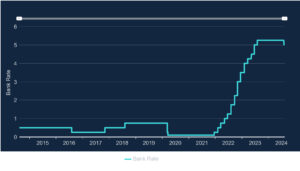The Bank of England base rate has been cut for the first time in four years to 5%. We take a look at what this means for mortgages and the housing market.
-
Base rate cut to 5% after 11 months at 5.25%
-
This cut is expected to deliver a confidence boost for home buyers
-
Average mortgage rates have already fallen this year
-
Fixed rate mortgages already factor in outlook for the base rate and are set to remain in 4-5% range into 2025
What’s happened to the base rate?
The Bank of England has cut the base rate by 0.25% to 5%. Base rates have been stuck at 5.25% for 11 months having risen rapidly from a low of 0.1% in November 2021. Higher base rates were needed to control inflation which is now back in line with the Bank’s target of 2%.
The decision to cut the base rate by 0.25% was finely balanced, but will be welcome news for businesses and households alike. It’s a sign that borrowing costs are likely to fall further, although how much further remains to be seen.
As we look to next year, economists are forecasting that it’s likely the base rate will fall to 4.6%–4.7% by the end of 2025.
What does the base rate cut mean for mortgages?
The cost of a mortgage is not directly set by the Bank of England official base rate. Lenders mainly source their finance for fixed rate mortgages in the money markets. The cost of this money is influenced by the expected direction of base rates, amongst other things. Most borrowers using a mortgage to buy a property are on fixed rate loans for 2 or 5 years.
Uncertainty over the outlook for the base rate over the last 3 years has led to the mortgage rate rising and falling between 4% and 6% for a typical 5 year fixed rate at 75% loan to value (LTV). These fluctuations have been driven by financial markets and their expectations for future borrowing costs.
At the start of 2024, there were expectations of several base rate cuts over the second half of the year. These expectations have been scaled back, and this explains why average mortgage rates have risen back above 4.5% for 5 year fixed rate loans in recent months.
The recent cut to the base rate may lead to mortgage rates returning to where they were earlier in the year. However, this depends on what the lenders think will happen to base rates into 2025.
How will this impact home buyers and the housing market?
The housing market is steadily adjusting to higher mortgage rates, with the worst of the impact felt in 2023.
2024 has got off to a good start: households that put decisions on hold last year have returned to the market knowing that base rates aren’t going to rise any higher.
The housing market is on track for 10% more homeowners moving compared to last year, and Zoopla expects average house prices to be 2% higher by the end of the year.
A key sign of confidence returning to the sales market is that buyers are paying almost 97% of the asking price. This is the highest it’s been for 18 months.
Mortgage rates of 4-5%, while higher than the ultra low rates of 2019-2021, are becoming more manageable for home buyers. This is demonstrated by more sellers and more sales being agreed. Further growth in household incomes will help improve affordability, especially as we expect incomes to rise faster than house prices over the next 18 months.
What’s the impact on the mortgage market?
The mortgage market remains very competitive with lenders offering a wide range of mortgage deals for all types of buyer. Rates are changing all the time and responding to the outlook for the cost of borrowing.
If you’re looking to take out a new mortgage within the next six months, you can approach individual banks and building societies to find out their best rates. Or, you can work with a mortgage broker who will scour the market to find the best deals available to you.
In summary now could be the best possible time to buy, as house prices have yet to adjust to the lower rates and if you’re looking to sell, a sale can be agreed more easily.




